Search results for 'vent'
-

Caleffi 548 Series Hydro Separator with ANSI Flanges-3" ANSI Flanged connection w/Insulation
0Series 548 Hydro Separator with ANSI Flanges. This device consists of several different functional components, each meet specific requirements, typical of the circuits used in heating and air-conditioning systems. • Hydronic separator: To keep connected hydronic circuits totally independent from each other • Dirt remover: To permit the separation and collection of any impurities present in the circuits. Provided with a valved connection with discharge piping. • Automatic air vent valve: For automatic venting of any air contained in the circuits. Provided with a valved connection for maintenance purposes. The hydronic separator should be sized according to the maximum flow rate value at the inlet. The selected design value must be the greatest between the primary circuit and the secondary circuit. When a single system contains a primary production circuit, with its own pump, and a secondary user circuit, with one or more distribution pumps, operating conditions may arise in the system whereby the pumps interact, creating abnormal variations in circuit flow rates and pressures. The hydronic separator creates a zone with a low pressure loss, which enables the primary and secondary circuits connected to it to be hydraulically independent of each other; the flow in one circuit does not create a flow in the other if the pressure loss in the common section is negligible. In this case, the flow rate in the respective circuits depends exclusively on the flow rate characteristics of the pumps, preventing reciprocal influence caused by connection in series. Therefore, using a device with these characteristics means that the flow in the secondary circuit only circulates when the relevant pump is on, permitting the system to meet the specific load requirements at that time. When the secondary pump is off, there is no circulation in the secondary circuit; the whole flow rate produced by the primary pump is by-passed through the separator. With the hydronic separator, it is thus possible to have a primary production circuit with a constant flow rate and a secondary distribution circuit with a variable flow rate; these operating conditions are typical of modern heating and cooling systems.Regular Price: $4,465.00
Special Price: $1,640.14
-
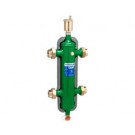
Caleffi 548 Series Hydro Separator-1-1/2" Sweat Union w/Insulation
Hydro Separator available in 1"-2" NPT & Sweat Unions. MAX operating pressure: 150 psi. Temperature range with insulation: 32-230 F. Medium: Water & Non-Hazardous Glycol solution. MAX percentage glycol: 50%.Series 548 Hydro Separator This device consists of several different functional components, each meet specific requirements, typical of the circuits used in heating and air-conditioning systems. • Hydronic separator: To keep connected hydronic circuits totally independent from each other • Dirt remover: To permit the separation and collection of any impurities present in the circuits. Provided with a valved connection with discharge piping. • Automatic air vent valve: For automatic venting of any air contained in the circuits. Provided with a valved connection for maintenance purposes. The hydronic separator should be sized according to the maximum flow rate value at 2" 37 the inlet. The selected design value must be the greatest between the primary circuit and the secondary circuit. When a single system contains a primary production circuit, with its own pump, and a secondary user circuit, with one or more distribution pumps, operating conditions may arise in the system whereby the pumps interact, crating abnormal variations in circuit flow rates and pressures. The hydronic separator creates a zone with a low pressure loss, which enables the primary and secondary circuits connected to it to be hydraulically independent of each other; the flow in one circuit does not create a flow in the other if the pressure loss in the common section is negligible. In this case, the flow rate in the respective circuits depends exclusively on the flow rate characteristics of the pumps, preventing reciprocal influence caused by connection in series. Therefore, using a device with these characteristics means that the flow in the secondary circuit only circulates when the relevant pump is on, permitting the system to meet the specific load requirements at that time. When the secondary pump is off, there is no circulation in the secondary circuit; the whole flow rate produced by the primary pump is by-passed through the separator. With the hydronic separator, it is thus possible to have a primary production circuit with a constant flow rate and a secondary distribution circuit with a variable flow rate; these operating conditions are typical of modern heating and cooling systems.$621.16 -
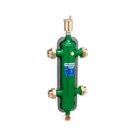
Caleffi 548 Series Hydro Separator-1-1/4" Sweat Union w/Insulation
Hydro Separator available in 1"-2" NPT & Sweat Unions. MAX operating pressure: 150 psi. Temperature range with insulation: 32-230 F. Medium: Water & Non-Hazardous Glycol solution. MAX percentage glycol: 50%.Series 548 Hydro Separator This device consists of several different functional components, each meet specific requirements, typical of the circuits used in heating and air-conditioning systems. • Hydronic separator: To keep connected hydronic circuits totally independent from each other • Dirt remover: To permit the separation and collection of any impurities present in the circuits. Provided with a valved connection with discharge piping. • Automatic air vent valve: For automatic venting of any air contained in the circuits. Provided with a valved connection for maintenance purposes. The hydronic separator should be sized according to the maximum flow rate value at 2" 37 the inlet. The selected design value must be the greatest between the primary circuit and the secondary circuit. When a single system contains a primary production circuit, with its own pump, and a secondary user circuit, with one or more distribution pumps, operating conditions may arise in the system whereby the pumps interact, crating abnormal variations in circuit flow rates and pressures. The hydronic separator creates a zone with a low pressure loss, which enables the primary and secondary circuits connected to it to be hydraulically independent of each other; the flow in one circuit does not create a flow in the other if the pressure loss in the common section is negligible. In this case, the flow rate in the respective circuits depends exclusively on the flow rate characteristics of the pumps, preventing reciprocal influence caused by connection in series. Therefore, using a device with these characteristics means that the flow in the secondary circuit only circulates when the relevant pump is on, permitting the system to meet the specific load requirements at that time. When the secondary pump is off, there is no circulation in the secondary circuit; the whole flow rate produced by the primary pump is by-passed through the separator. With the hydronic separator, it is thus possible to have a primary production circuit with a constant flow rate and a secondary distribution circuit with a variable flow rate; these operating conditions are typical of modern heating and cooling systems.$474.59 -

Caleffi 548 Series Hydro Separator with ANSI Flanges-6" ANSI Flanged connection without Insulation ASME
Without Insulation ASME tagged and registeredSeries 548 Hydro Separator with ANSI Flanges. This device consists of several different functional components, each meet specific requirements, typical of the circuits used in heating and air-conditioning systems. • Hydronic separator: To keep connected hydronic circuits totally independent from each other • Dirt remover: To permit the separation and collection of any impurities present in the circuits. Provided with a valved connection with discharge piping. • Automatic air vent valve: For automatic venting of any air contained in the circuits. Provided with a valved connection for maintenance purposes. The hydronic separator should be sized according to the maximum flow rate value at the inlet. The selected design value must be the greatest between the primary circuit and the secondary circuit. When a single system contains a primary production circuit, with its own pump, and a secondary user circuit, with one or more distribution pumps, operating conditions may arise in the system whereby the pumps interact, creating abnormal variations in circuit flow rates and pressures. The hydronic separator creates a zone with a low pressure loss, which enables the primary and secondary circuits connected to it to be hydraulically independent of each other; the flow in one circuit does not create a flow in the other if the pressure loss in the common section is negligible. In this case, the flow rate in the respective circuits depends exclusively on the flow rate characteristics of the pumps, preventing reciprocal influence caused by connection in series. Therefore, using a device with these characteristics means that the flow in the secondary circuit only circulates when the relevant pump is on, permitting the system to meet the specific load requirements at that time. When the secondary pump is off, there is no circulation in the secondary circuit; the whole flow rate produced by the primary pump is by-passed through the separator. With the hydronic separator, it is thus possible to have a primary production circuit with a constant flow rate and a secondary distribution circuit with a variable flow rate; these operating conditions are typical of modern heating and cooling systems.Regular Price: $10,280.00
Special Price: $3,776.19
-
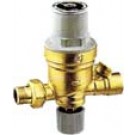
Caleffi Series 553 Automatic Filling Units 1/2"Union NPT Male Inlet with 1/2" NPT Female Outlet
Caleffi Series 553 Automatic Filling UnitsThe AutoFill™ automatic filling valve is a pressure reducing valve with a compensating seat, an inlet filter, a shut-off valve and a check valve. It is installed on the water inlet piping in sealed heating systems, and its main function is to maintain the pressure of the system to a preset value, automatically filling up with water as required. This valve has been designed as pre-adjustable, which means it can be adjusted at the required pressure value before charging the system. After installation, during the filling or topping-off phase, the water feed will stop automatically when the set pressure is reached. There are no levers to flip or valve to close. Preassembled with the backflow preventer, it features an atmospheric vent which is designed to protect drinking water systems from return flow, caused by back-siphoning or backpressure, of contaminated fluids. The 573 series has been specifically certified to standards CSA B64.3 and ASSE 1012.$50.39 -
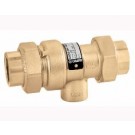
Caleffi Series 573 Backflow Preventers 1/2" Sweat Inlet/Outlet
Caleffi Series 573 Backflow Preventers 1/2" Sweat Inlet/OutletDual check continuous pressure backflow preventer with atmospheric vent. Brass body. Max. working pressure: 175 psi. Working temperature range: 32—210°F. ASSE 1012 listed and CSA B64.3 certified.$39.29 -
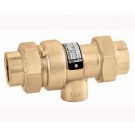
Caleffi Series 573 Backflow Preventer 1/2" NPT Female Inlet/Outlet
Caleffi Series 573 Backflow Preventer 1/2" NPT Female Inlet/OutletDual check continuous pressure backflow preventer with atmospheric vent. Brass body. Max. working pressure: 175 psi. Working temperature range: 32—210°F. ASSE 1012 listed and CSA B64.3 certified.$39.29 -

Caleffi 548 Series Hydro Separator-1" Sweat Union w/Insulation
Hydro Separator available in 1"-2" NPT & Sweat Unions. MAX operating pressure: 150 psi. Temperature range with insulation: 32-230 F. Medium: Water & Non-Hazardous Glycol solution. MAX percentage glycol: 50%.Series 548 Hydro Separator This device consists of several different functional components, each meet specific requirements, typical of the circuits used in heating and air-conditioning systems. • Hydronic separator: To keep connected hydronic circuits totally independent from each other • Dirt remover: To permit the separation and collection of any impurities present in the circuits. Provided with a valved connection with discharge piping. • Automatic air vent valve: For automatic venting of any air contained in the circuits. Provided with a valved connection for maintenance purposes. The hydronic separator should be sized according to the maximum flow rate value at 2" 37 the inlet. The selected design value must be the greatest between the primary circuit and the secondary circuit. When a single system contains a primary production circuit, with its own pump, and a secondary user circuit, with one or more distribution pumps, operating conditions may arise in the system whereby the pumps interact, crating abnormal variations in circuit flow rates and pressures. The hydronic separator creates a zone with a low pressure loss, which enables the primary and secondary circuits connected to it to be hydraulically independent of each other; the flow in one circuit does not create a flow in the other if the pressure loss in the common section is negligible. In this case, the flow rate in the respective circuits depends exclusively on the flow rate characteristics of the pumps, preventing reciprocal influence caused by connection in series. Therefore, using a device with these characteristics means that the flow in the secondary circuit only circulates when the relevant pump is on, permitting the system to meet the specific load requirements at that time. When the secondary pump is off, there is no circulation in the secondary circuit; the whole flow rate produced by the primary pump is by-passed through the separator. With the hydronic separator, it is thus possible to have a primary production circuit with a constant flow rate and a secondary distribution circuit with a variable flow rate; these operating conditions are typical of modern heating and cooling systems.$393.41 -
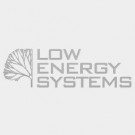
Tjernlund GPAK-J Side Wall Vent System
4" Diameter Vent System for up 150k BTU-
-
All operating components located indoors for weather
-
Capacities up to 250,000 BTU/hr.
-
Accommodates vent pipe runs up to 100 equivalent feet.
-
Regulated, consistent draft throughout burner cycle.
-
Built-in Fan Proving Switch interlocks with gas valve.
-
Available with 24-volt Relay or Post Purge Timer/Relay.
-
Kit includes everything needed for installation, except vent pipe. (*GPAK* includes DC-4 Draft Control)
-
Durable, heavy-duty aluminum Vent Hood.
-
AGA design certified for gas furnaces, boilers, pool
- heaters, unit heaters and commercial water heaters.
-
$199.00 -
-

Duravent PPS Locking Band 2" Diameter
Use to secure two sections of PPS pipe together. Required to comply with ULC-S636 listed installations. Available in 2", 3", and 4" diameter.PolyPro is a polypropylene vent pipe for use with ANSI Category II and IV gas burning appliances, including tankless and storage water heaters, high-efficiency water heaters, condensing boilers and warm air furnaces. PolyPro is listed by Intertek to the ULC S636 standard in Canada and is rated as a Class IIA, IIB and IIC vent system suitable for exhaust temperatures up to 230°F / 110°C, and a maximum positive pressure of 15 in-w.c.$7.02



